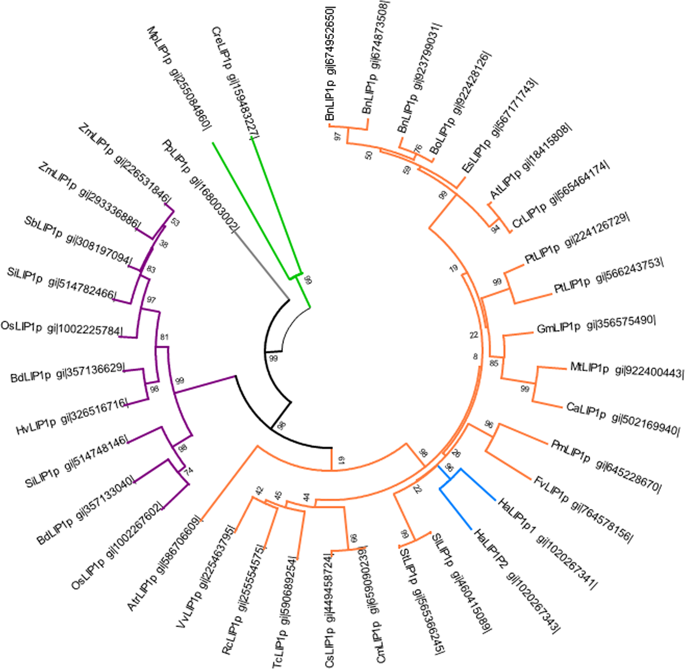Our official English website, www.x-mol.net, welcomes your
feedback! (Note: you will need to create a separate account there.)
Impact of sunflower (Helianthus annuus L.) plastidial lipoyl synthases genes expression in glycerolipids composition of transgenic Arabidopsis plants.
Scientific Reports ( IF 3.8 ) Pub Date : 2020-02-28 , DOI: 10.1038/s41598-020-60686-z Raquel Martins-Noguerol 1, 2 , Antonio Javier Moreno-Pérez 1, 2 , Acket Sebastien 2 , Manuel Adrián Troncoso-Ponce 2 , Rafael Garcés 1 , Brigitte Thomasset 2 , Joaquín J Salas 1 , Enrique Martínez-Force 1
Scientific Reports ( IF 3.8 ) Pub Date : 2020-02-28 , DOI: 10.1038/s41598-020-60686-z Raquel Martins-Noguerol 1, 2 , Antonio Javier Moreno-Pérez 1, 2 , Acket Sebastien 2 , Manuel Adrián Troncoso-Ponce 2 , Rafael Garcés 1 , Brigitte Thomasset 2 , Joaquín J Salas 1 , Enrique Martínez-Force 1
Affiliation

|
Lipoyl synthases are key enzymes in lipoic acid biosynthesis, a co-factor of several enzyme complexes involved in central metabolism. Plant pyruvate dehydrogenase complex (PDH), located in mitochondria and plastids, catalyses the first step of fatty acid biosynthesis in these organelles. Among their different components, the E2 subunit requires the lipoic acid prosthetic group to be active. De novo lipoic acid biosynthesis is achieved by the successive action of two enzymes on octanoyl-ACP: octanoyltransferase (LIP2) and lipoyl synthase (LIP1). In this study, two plastidial lipoyl synthase genes from sunflower (Helianthus annuus L.) were identified (HaLIP1p1 and HaLIP1p2), sequenced and cloned in a heterologous production system (Escherichia coli). Gene expression studies revealed similar expression patterns for both isoforms, with a slight predominance of HaLIP1p1 in vegetative tissues and mature seeds. Tertiary structural models for these enzymes indicate they both have the same theoretical catalytic sites, using lipoyl-lys and 5-deoxyadenosine as docking substrates. The fatty acid profile of E. coli cells overexpressing HaLIP1p1 and HaLIP1p2 did not present major differences, and the in vivo activity of both proteins was confirmed by complementation of an E. coli JW0623 mutant in which lipoyl synthase is defective. Although no significant differences were detected in the total fatty acid composition of transgenic Arabidopsis thaliana seeds overexpressing any of both proteins, a lipidomic analysis revealed a redistribution of the glycerolipid species, accompanied with increased phosphatidylethanolamine (PE) content and a decrease in diacyglycerols (DAG) and phosphatidylcholine (PC). Depletion of the SAM co-factor caused by HaLIP1p1 and HaLIP1p2 overexpression in transgenic plants could explain this remodelling through its effects on PC synthesis.
中文翻译:

向日葵(Helianthus annuus L.)质体硫辛酰合酶基因在转基因拟南芥植物甘油脂成分中表达的影响。
硫辛酰合酶是硫辛酸生物合成中的关键酶,是参与中枢代谢的几种酶复合物的辅助因子。植物丙酮酸脱氢酶复合物 (PDH) 位于线粒体和质体中,催化这些细胞器中脂肪酸生物合成的第一步。在它们的不同成分中,E2亚基需要硫辛酸辅基才能发挥活性。硫辛酸从头生物合成是通过两种酶对辛酰-ACP 的连续作用实现的:辛酰转移酶 (LIP2) 和硫辛酰合酶 (LIP1)。在本研究中,鉴定了来自向日葵(Helianthus annuus L.)的两个质体硫辛酰合酶基因(HaLIP1p1 和 HaLIP1p2),并在异源生产系统(大肠杆菌)中进行测序和克隆。基因表达研究揭示了两种亚型的相似表达模式,其中 HaLIP1p1 在营养组织和成熟种子中略有优势。这些酶的三级结构模型表明它们都具有相同的理论催化位点,使用硫辛酰赖氨酸和 5-脱氧腺苷作为对接底物。过表达 HaLIP1p1 和 HaLIP1p2 的大肠杆菌细胞的脂肪酸谱没有出现重大差异,两种蛋白的体内活性通过硫辛酰合酶缺陷的大肠杆菌 JW0623 突变体的互补得到证实。虽然过表达这两种蛋白的转基因拟南芥种子的总脂肪酸组成没有检测到显着差异,但脂质组学分析揭示了甘油脂种类的重新分布,伴随着磷脂酰乙醇胺 (PE) 含量的增加和二酰甘油 (DAG) 的减少和磷脂酰胆碱(PC)。 转基因植物中 HaLIP1p1 和 HaLIP1p2 过度表达导致 SAM 辅因子的消耗,可以通过其对 PC 合成的影响来解释这种重塑。
更新日期:2020-02-28
中文翻译:

向日葵(Helianthus annuus L.)质体硫辛酰合酶基因在转基因拟南芥植物甘油脂成分中表达的影响。
硫辛酰合酶是硫辛酸生物合成中的关键酶,是参与中枢代谢的几种酶复合物的辅助因子。植物丙酮酸脱氢酶复合物 (PDH) 位于线粒体和质体中,催化这些细胞器中脂肪酸生物合成的第一步。在它们的不同成分中,E2亚基需要硫辛酸辅基才能发挥活性。硫辛酸从头生物合成是通过两种酶对辛酰-ACP 的连续作用实现的:辛酰转移酶 (LIP2) 和硫辛酰合酶 (LIP1)。在本研究中,鉴定了来自向日葵(Helianthus annuus L.)的两个质体硫辛酰合酶基因(HaLIP1p1 和 HaLIP1p2),并在异源生产系统(大肠杆菌)中进行测序和克隆。基因表达研究揭示了两种亚型的相似表达模式,其中 HaLIP1p1 在营养组织和成熟种子中略有优势。这些酶的三级结构模型表明它们都具有相同的理论催化位点,使用硫辛酰赖氨酸和 5-脱氧腺苷作为对接底物。过表达 HaLIP1p1 和 HaLIP1p2 的大肠杆菌细胞的脂肪酸谱没有出现重大差异,两种蛋白的体内活性通过硫辛酰合酶缺陷的大肠杆菌 JW0623 突变体的互补得到证实。虽然过表达这两种蛋白的转基因拟南芥种子的总脂肪酸组成没有检测到显着差异,但脂质组学分析揭示了甘油脂种类的重新分布,伴随着磷脂酰乙醇胺 (PE) 含量的增加和二酰甘油 (DAG) 的减少和磷脂酰胆碱(PC)。 转基因植物中 HaLIP1p1 和 HaLIP1p2 过度表达导致 SAM 辅因子的消耗,可以通过其对 PC 合成的影响来解释这种重塑。





















































 京公网安备 11010802027423号
京公网安备 11010802027423号